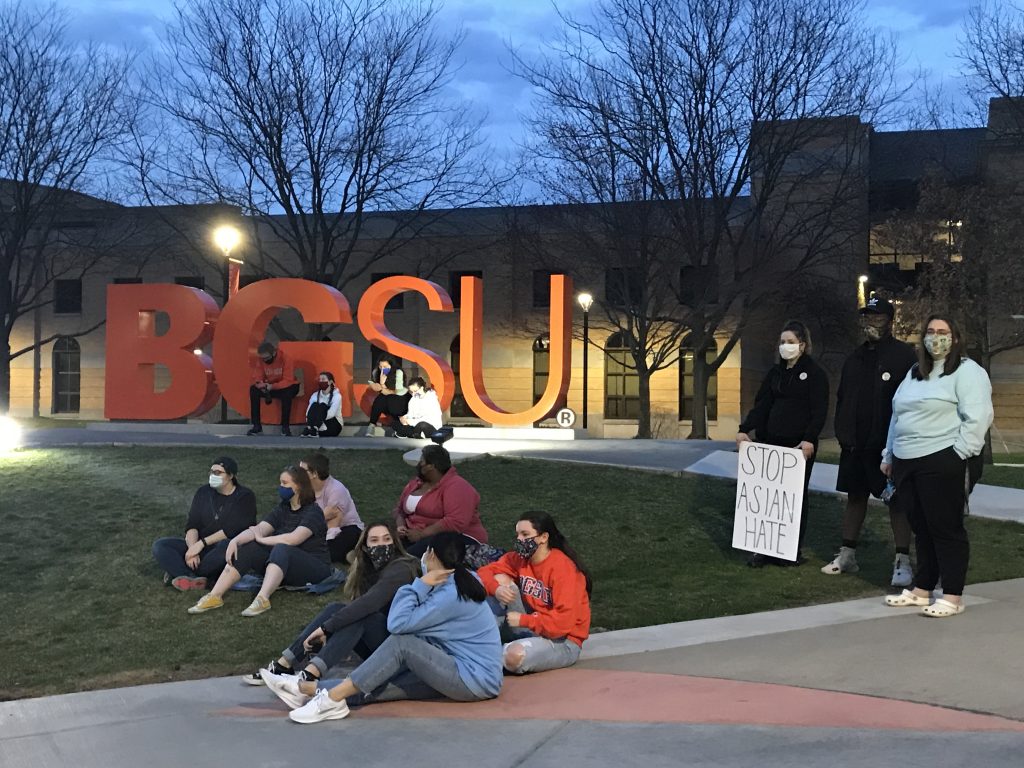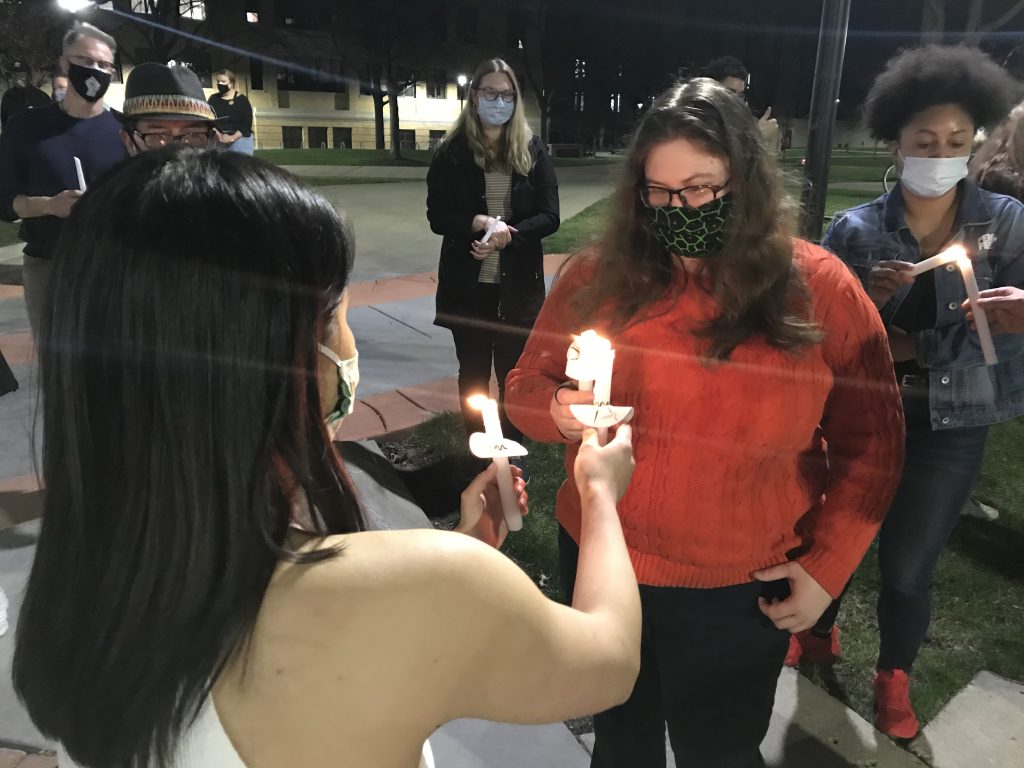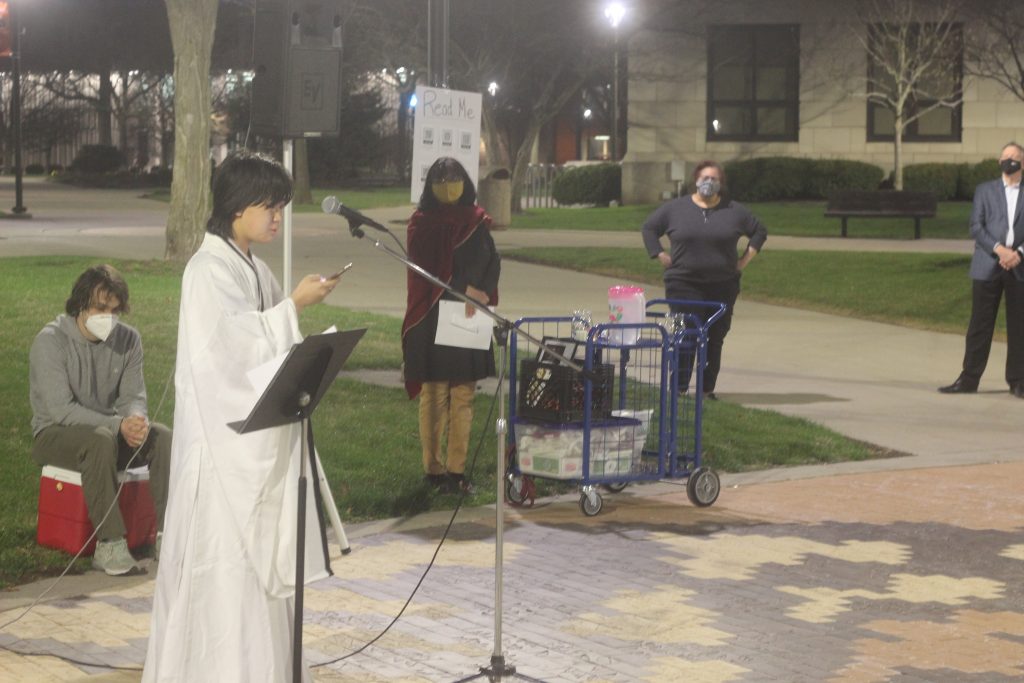By DAVID DUPONT
BG Independent News
Those gathered on campus Tuesday for a vigil for the victims of the Atlanta shootings took a long view of prejudice against Asians in America.
They also heard of the latest instance of violence – an assault on a 65-year-old Filipino woman in New York City on Monday.
About 80 people, including President Rodney Rogers, attended the vigil organized by the Bowling Green State University Asian Student Union to remember the eight victims of the March 16 mass shooting.

Sophia Michalski said when her parents, who are White, asked her if she was all right after news of the Atlanta shooting broke. She said “yes.” But it was within the Asian Student Union that she found the safe place “to understand what I was going through.”
The vigil was intended to offer that kind of empowering space for others, Michalski, an executive board member, said.
Then student Leon Wang read their poem: “We Don’t Need to Prove that We Deserve to Live.”
Though officials in Georgia have not categorized the killing as being racially motivated, giving credence to the alleged murderer’s claim the victims were “temptations” to him, the killings fit into a long history of racist stereotypes about Asians, and Asian women in particular.
And while some have lamented that “this is not America,” said Professor Rebecca Kinney. “This is America.”
Kinney said she is subjected to racial slurs shouted at her and unwanted advances. Though she grew up in Michigan, some assume she is a foreigner.
This worsened in the past year, as former President Donald Trump labeled the coronavirus as an Asian phenomenon.
This anti-Asian sentiment is part of the fabric of white supremacy, of a system that labels “White schools” as “good” and “Black” schools” as “bad” and “White neighborhoods” as “good,” and “Black neighborhoods” as “dangerous.”
After the Atlanta killings, Kinney was discussing the situation with a Black friend, and they agreed they must also confront the racism within their own communities, because that, too, is part of the dynamic of white supremacy.
Kinney urged those present “to do the work.” Confronting one’s own biases is “messy” and “uncomfortable,” but it is essential.

Despite the arrival of Chinese in 1849, about the same time as the arrival of the wave of Irish immigrants, Asians are not considered truly American,” said Professor Vibha Bhalla.
She recounted the story of 69-year-old Lee Wong, a town official in Chester, Ohio, who tired of rising anti-Asian sentiment lifted his shirt during a meeting to show scars sustained while in the Army, and asked : “Is this patriot enough?”
He had lived in USA for 51 years yet his loyalty to the country was being question.
Asians have been coming here since 1849, “yet in the American imagination they remain the other.”
When tensions with tensions with Asian nations rise, Asian-Americans suffer the brunt, she said.
“Please understand that Asian-Americans belong to America.”
Trinidad Linares, who works in the University Library, spoke specifically of the experience of Filipino Americans. The two countries have a long and tangled history. Her family came to the United States, she said, fleeing a corrupt regime supported by the American government.
Filipino and Filipino-American women have long served as nurses in the United States, she said. And during the pandemic, though only 4 percent of nurses are ethnically Filipino, studies have shown they account for about a third of the nurses who have died from COVID-19.
Professor Tarishi Verma spoke of enjoying recent media portrayals such as in the film “Rich Crazy Asians.” But those cannot make up for media images the lingering stereotype.
Asian women have been “hypersexualized.” In 1875, immigration law was changed to all but prohibit women from China and Japan coming to the United States because they were assumed to be coming to perform sex work.
Low wage earning Asian women continue to suffer from this stigma.
But the focus on Asian-Americans as “the model minority” makes these people invisible, she said..
If some Asian-Americans become engineers, lawyers, and doctors how can they talk about a lack of mobility.
Verma urged those at the rally to be “active bystanders” not like those who witnessed the recent attack in New York, and shut the door and didn’t help.
“Be the change,” she said. “Start today, so tomorrow we don’t have to gather here to perform our individual and collective trauma in front of others. Start today, so tomorrow we can gather to celebrate instead.”
Michael Ogawa, BGSU vice president for research and economic engagement, said he was “gratified to see this show of support.”
“There are many different reasons why we are here – acts of violence, the rising tide of xenophobia. For those of us who are Asian-American, it’s to honor the struggles our families have gone through.”
For his family, which first immigrated in 1905, that included “spending three years behind barbed wire in World War II.”
He praised the Asian Students Union for the support the organization provides. “Being an Asian American is difficult. It’s confusing, nuanced, but it’s also something to take great pride in, to take strength from,” he said. “I’m glad you have each other, and thank you for bringing us all together.”

The vigil came to a formal close with a collective reading of Wang’s poem.
The poem ends with the lines:
“I have a dream
“That people of every hue
“Will see us as humans
“Not your nerds and not your whores
“We are simply humans
“Nothing less and nothing more.”

